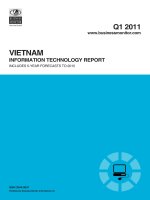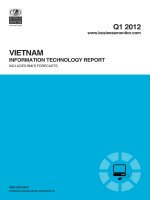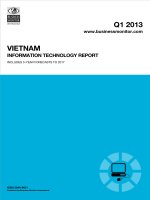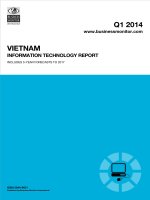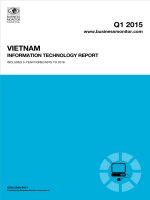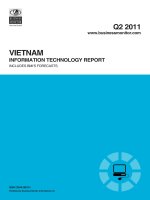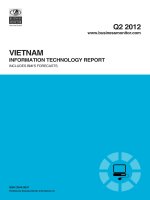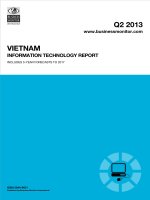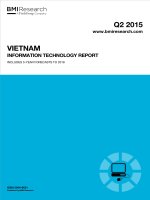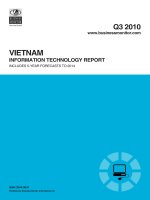Vietnam information technology report q2 2016
Bạn đang xem bản rút gọn của tài liệu. Xem và tải ngay bản đầy đủ của tài liệu tại đây (354.64 KB, 73 trang )
Q2 2016
www.bmiresearch.com
VIETNAM
INFORMATION TECHNOLOGY REPORT
INCLUDES 5-YEAR FORECASTS TO 2020
Published by:BMI Research
Vietnam Information Technology Report
Q2 2016
INCLUDES 5-YEAR FORECASTS TO 2020
Part of BMI’s Industry Report & Forecasts Series
Published by: BMI Research
Copy deadline: March 2016
ISSN: 2044-9631
BMI Research
Senator House
85 Queen Victoria Street
London
EC4V 4AB
United Kingdom
Tel: +44 (0) 20 7248 0468
Fax: +44 (0) 20 7248 0467
Email:
Web:
© 2016 Business Monitor International Ltd
All rights reserved.
All information contained in this publication is
copyrighted in the name of Business Monitor
International Ltd, and as such no part of this
publication may be reproduced, repackaged,
redistributed, resold in whole or in any part, or used
in any form or by any means graphic, electronic or
mechanical, including photocopying, recording,
taping, or by information storage or retrieval, or by
any other means, without the express written consent
of the publisher.
DISCLAIMER
All information contained in this publication has been researched and compiled from sources believed to be accurate and reliable at the time of
publishing. However, in view of the natural scope for human and/or mechanical error, either at source or during production, Business Monitor
International Ltd accepts no liability whatsoever for any loss or damage resulting from errors, inaccuracies or omissions affecting any part of the
publication. All information is provided without warranty, and Business Monitor International Ltd makes no representation of warranty of any kind
as to the accuracy or completeness of any information hereto contained.
Vietnam Information Technology Report
Q2 2016
INCLUDES 5-YEAR FORECASTS TO 2020
Part of BMI’s Industry Report & Forecasts Series
Published by: BMI Research
Copy deadline: March 2016
ISSN: 2044-9631
BMI Research
Senator House
85 Queen Victoria Street
London
EC4V 4AB
United Kingdom
Tel: +44 (0) 20 7248 0468
Fax: +44 (0) 20 7248 0467
Email:
Web:
© 2016 Business Monitor International Ltd
All rights reserved.
All information contained in this publication is
copyrighted in the name of Business Monitor
International Ltd, and as such no part of this
publication may be reproduced, repackaged,
redistributed, resold in whole or in any part, or used
in any form or by any means graphic, electronic or
mechanical, including photocopying, recording,
taping, or by information storage or retrieval, or by
any other means, without the express written consent
of the publisher.
DISCLAIMER
All information contained in this publication has been researched and compiled from sources believed to be accurate and reliable at the time of
publishing. However, in view of the natural scope for human and/or mechanical error, either at source or during production, Business Monitor
International Ltd accepts no liability whatsoever for any loss or damage resulting from errors, inaccuracies or omissions affecting any part of the
publication. All information is provided without warranty, and Business Monitor International Ltd makes no representation of warranty of any kind
as to the accuracy or completeness of any information hereto contained.
Vietnam Information Technology Report Q2 2016
CONTENTS
BMI Industry View ............................................................................................................... 7
SWOT .................................................................................................................................... 9
IT SWOT .................................................................................................................................................. 9
Industry Forecast .............................................................................................................. 11
Latest Updates ....................................................................................................................................... 11
Structural Trends ................................................................................................................................... 11
Table: Enterprise Trends - GVA By Vertical (Vietnam 2015-2020) . . . . . . . . . . . . . . . . . . . . . . . . . . . . . . . . . . . . . . . . . . . . . . . . . . . . . . . . . . . . . . . . . . . . . . . . . . . . . . . . . . . . 16
Table: IT Industry - Historical Data And Forecasts (Vietnam 2013-2020) . . . . . . . . . . . . . . . . . . . . . . . . . . . . . . . . . . . . . . . . . . . . . . . . . . . . . . . . . . . . . . . . . . . . . . . . . . . . 17
Industry Risk Reward Index ............................................................................................. 18
Table: IT RRI Score Breakdown By Region . . . . . . . . . . . . . . . . . . . . . . . . . . . . . . . . . . . . . . . . . . . . . . . . . . . . . . . . . . . . . . . . . . . . . . . . . . . . . . . . . . . . . . . . . . . . . . . . . . . . . . . . . . . . 19
Table: Asia Pacific IT Risk/Reward Index - Q2 2016 . . . . . . . . . . . . . . . . . . . . . . . . . . . . . . . . . . . . . . . . . . . . . . . . . . . . . . . . . . . . . . . . . . . . . . . . . . . . . . . . . . . . . . . . . . . . . . . . . . 21
Market Overview ............................................................................................................... 22
Recent Developments ..............................................................................................................................
Hardware .............................................................................................................................................
Software ...............................................................................................................................................
Cloud Computing ...................................................................................................................................
Services ................................................................................................................................................
22
22
28
34
38
Industry Trends And Developments ................................................................................ 43
Regulatory Development .................................................................................................. 49
Table: Government Authority . . . . . . . . . . . . . . . . . . . . . . . . . . . . . . . . . . . . . . . . . . . . . . . . . . . . . . . . . . . . . . . . . . . . . . . . . . . . . . . . . . . . . . . . . . . . . . . . . . . . . . . . . . . . . . . . . . . . . . . . . . . 49
Regulatory News .................................................................................................................................... 52
Competitive Landscape .................................................................................................... 54
International Companies ......................................................................................................................... 54
Table: Global CyberSoft . . . . . . . . . . . . . . . . . . . . . . . . . . . . . . . . . . . . . . . . . . . . . . . . . . . . . . . . . . . . . . . . . . . . . . . . . . . . . . . . . . . . . . . . . . . . . . . . . . . . . . . . . . . . . . . . . . . . . . . . . . . . . . . . 54
Table: Intel . . . . . . . . . . . . . . . . . . . . . . . . . . . . . . . . . . . . . . . . . . . . . . . . . . . . . . . . . . . . . . . . . . . . . . . . . . . . . . . . . . . . . . . . . . . . . . . . . . . . . . . . . . . . . . . . . . . . . . . . . . . . . . . . . . . . . . . . . . . . . . 55
Table: LG Electronics . . . . . . . . . . . . . . . . . . . . . . . . . . . . . . . . . . . . . . . . . . . . . . . . . . . . . . . . . . . . . . . . . . . . . . . . . . . . . . . . . . . . . . . . . . . . . . . . . . . . . . . . . . . . . . . . . . . . . . . . . . . . . . . . . . 56
Table: Samsung Electronics . . . . . . . . . . . . . . . . . . . . . . . . . . . . . . . . . . . . . . . . . . . . . . . . . . . . . . . . . . . . . . . . . . . . . . . . . . . . . . . . . . . . . . . . . . . . . . . . . . . . . . . . . . . . . . . . . . . . . . . . . . . . 57
Local Companies ................................................................................................................................... 58
Table: Sara Vietnam . . . . . . . . . . . . . . . . . . . . . . . . . . . . . . . . . . . . . . . . . . . . . . . . . . . . . . . . . . . . . . . . . . . . . . . . . . . . . . . . . . . . . . . . . . . . . . . . . . . . . . . . . . . . . . . . . . . . . . . . . . . . . . . . . . . . 58
Regional Overview ............................................................................................................ 59
Demographic Forecast ..................................................................................................... 63
Table: Population Headline Indicators (Vietnam 1990-2025) . . . . . . . . . . . . . . . . . . . . . . . . . . . . . . . . . . . . . . . . . . . . . . . . . . . . . . . . . . . . . . . . . . . . . . . . . . . . . . . . . . . . . . . . . 64
Table: Key Population Ratios (Vietnam 1990-2025) . . . . . . . . . . . . . . . . . . . . . . . . . . . . . . . . . . . . . . . . . . . . . . . . . . . . . . . . . . . . . . . . . . . . . . . . . . . . . . . . . . . . . . . . . . . . . . . . . . . 64
Table: Urban/Rural Population & Life Expectancy (Vietnam 1990-2025) . . . . . . . . . . . . . . . . . . . . . . . . . . . . . . . . . . . . . . . . . . . . . . . . . . . . . . . . . . . . . . . . . . . . . . . . . . . . 65
Table: Population By Age Group (Vietnam 1990-2025) . . . . . . . . . . . . . . . . . . . . . . . . . . . . . . . . . . . . . . . . . . . . . . . . . . . . . . . . . . . . . . . . . . . . . . . . . . . . . . . . . . . . . . . . . . . . . . . 65
© Business Monitor International Ltd
Page 4
Vietnam Information Technology Report Q2 2016
Table: Population By Age Group % (Vietnam 1990-2025) . . . . . . . . . . . . . . . . . . . . . . . . . . . . . . . . . . . . . . . . . . . . . . . . . . . . . . . . . . . . . . . . . . . . . . . . . . . . . . . . . . . . . . . . . . . . 66
Methodology ...................................................................................................................... 68
Industry Forecast Methodology ................................................................................................................ 68
Sources ................................................................................................................................................ 70
Risk/Reward Index Methodology ............................................................................................................... 70
Table: IT Risk/Reward Index Indicators . . . . . . . . . . . . . . . . . . . . . . . . . . . . . . . . . . . . . . . . . . . . . . . . . . . . . . . . . . . . . . . . . . . . . . . . . . . . . . . . . . . . . . . . . . . . . . . . . . . . . . . . . . . . . . . . 71
Table: Weighting Of Components . . . . . . . . . . . . . . . . . . . . . . . . . . . . . . . . . . . . . . . . . . . . . . . . . . . . . . . . . . . . . . . . . . . . . . . . . . . . . . . . . . . . . . . . . . . . . . . . . . . . . . . . . . . . . . . . . . . . . . 72
© Business Monitor International Ltd
Page 5
Vietnam Information Technology Report Q2 2016
BMI Industry View
BMI View: Vietnam is a rapidly developing IT market, with strong momentum across the hardware,
software and services segments. We expect this growth dynamic to be maintained over the medium term
based on robust economic performance and a supportive policy framework that is both helping to grow the
market and develop Vietnam's IT industry. For the retail hardware market broad-based economic growth
that will deepen the retail hardware market, as well as easing price sensitivity in the higher-value
replacement market is a central component of our outlook. For software and services economic
modernisation and the development of higher productivity verticals in the economy present major
opportunities to vendors. We forecast an IT spending CAGR of 10.2% over 2016-2020 to total sales of
VND103.4trn in 2020.
Latest Updates And Industry Developments
■
Computer Hardware Sales: VND42.3trn in 2016 to VND55.3trn in 2020, a compound annual growth
rate (CAGR) of +6.9%. Outlook downgraded in Q216 due to expectation for greater cannibalisation of
tablet purchases by smartphones, but overall outlook still positive due to income growth trends.
■
Software Sales: VND10.8trn in 2016 to VND17.8trn in 2020, a CAGR of +13.3%. Substantial
opportunities exist in enterprise software market where there is low penetration.
■
IT Services Sales: VND17.1trn in 2016 to VND30.3trn in 2020, a CAGR of +15.4%. Potential for core
solution spending growth, and a booming cloud computing and outsourcing markets expected to underpin
IT services outperformance 2016-2020.
© Business Monitor International Ltd
Page 7
Vietnam Information Technology Report Q2 2016
Bright Outlook For IT Spending Across All Three Segments
IT Market Forecast By Segment
60,000,000
40,000,000
20,000,000
0
2014
2015e
2016f
2017f
2018f
2019f
2020f
Vietnam - Computer hardware sales, VNDmn
Vietnam - Software sales, VNDmn
Vietnam - Services sales, VNDmn
e/f = BMI estimate/forecast. Source: BMI
© Business Monitor International Ltd
Page 8
Vietnam Information Technology Report Q2 2016
SWOT
IT SWOT
SWOT Analysis
Strengths
■
Supportive policy framework and funding in place to promote the development of the
IT sector.
■
Vietnam's gradual integration into the global trade network via its accession into trade
organisations such as the Association of Southeast Asian Nations and WTO, as well
as bilateral agreements with Japan and China.
■
The domestic IT market is in a rapid growth phase, with trade liberalisation and
growing affordability driving increased adoption among enterprises and consumers.
■
Expanding local hardware production industry with major international players such
as Samsung, Nokia, LG and Intel making large investments.
■
Vietnam is a preeminent global outsourcing destination, with a particular strength in
the software development industry.
Weaknesses
■
IT spend per capita is much lower than in neighbouring Thailand, reflecting a much
lower GDP per capita.
■
Highly price-sensitive market, putting pressure on vendor margins.
■
High level of software piracy, with a stall in the reduction 2011 to 2013.
■
Cybersecurity measures by the government have been pushed through with state
security measures, with potential human rights implications.
Opportunities
■
Broad-based economic growth forecast to drive retail hardware market growth as
household incomes increase markedly 2016-2020.
■
Decision in July 2014 to enable state agencies to use outsourced information
technology providers for the first time opens a new growth channel for vendors.
© Business Monitor International Ltd
Page 9
Vietnam Information Technology Report Q2 2016
SWOT Analysis - Continued
■
TPP a driver for regional integration of Vietnam's already successful software
development and IT services outsourcing industry, allowing the industry to target
more customers in high value markets such as Japan.
■
E-government adoption deepening, with opportunities in government administration,
alongside sector-specific markets such as healthcare.
■
Low PC penetration means there is scope for vendors to tap first-time buyer market
as well as the upgrade/replacement market.
■
Notebooks, and hybrids, offer potential for continued growth in the PC market.
■
Small- and medium-sized enterprises have much potential to increase spending on
basic solutions, including customer relationship management and security.
■
The government's drive to create an IT services industry over the next 15-20 years including the National Technology Innovation Fund - is expected to accelerate the
development of local enterprises.
■
Cloud computing awareness has risen fast and adoption is expected to accelerate in
the short-to-medium term as network infrastructure improves and awareness levels
increase.
Threats
■
Competition from smartphones, and intense price competition, dampen the retail PC
market outlook.
■
Cybersecurity issues could undermine confidence in IT solutions and services, with
big data and cloud computing vulnerable.
■
Yen depreciation has hit the software outsourcing market by making exports less
competitive and eroding Vietnam's cost advantages.
© Business Monitor International Ltd
Page 10
Vietnam Information Technology Report Q2 2016
Industry Forecast
BMI View: Even after a small downgrade to the growth outlook in the Q216 update we have a bullish
outlook for IT market performance in Vietnam over 2016-2020, forecast a CAGR of 10.2% to VND103.4trn
in 2020. We moderated our IT hardware growth forecast this quarter to reflect a stronger dynamic of tablet
volumes being cannibalised by smartphones, but based on low PC penetration and broad-based income
growth the overall outlook is still bright. We expect enterprise software and services spending to perform
even better, through the shift towards higher productivity activities such as manufacturing and outsourcing,
a supportive policy environment and investments in network infrastructure all supplementing the economic
outlook.
Latest Updates
■
Small downgrade to the hardware segment forecast where we now envisage a weaker growth dynamic for
tablets, particularly for low-end small screen devices, as consumers show a stronger preference for
smartphone ownership.
■
Overall PC market forecast is positive, based on our identification of broad-based economic growth
trends that we believe will extend through to 2020.
■
Software and services growth potential is significant, with enterprise modernisation, migration to higher
productivity activities for the economy as a whole and supportive policy environment the central drivers.
Structural Trends
2016 Outlook
Vietnam was an outperformer in 2015 and was spared the worst impacts of regional economic uncertainty
after fears of a China hard landing elevated in August 2015, there was nonetheless a dip in IT market
growth to 8.2%. An additional factor was the decline in tablet volumes after the sharp boom in 2014 when
low-cost devices flooded the market, and the concentration of desktop and notebook replacement spending
in 2014 due to the withdrawal of Microsoft support for XP.
As economic and product trends become more favourable in 2016, BMI forecasts an acceleration in IT
market spending growth to 8.6%, with a total value of VND70.2trn envisaged. There is still downside due
regional economic uncertainty and domestically from potential credit tightening. We do not however
envisage major disruption as Vietnam has been relatively proactive in tackling bad debt. The official rate of
non-performing loans was down from 4.2% in December 2012 to 2.9% in September 2015, while State
Bank of Vietnam is leading banking industry consolidation to reduce the number of banks from 40 to 15,
which will help to insulate against shocks. Furthermore, with access to credit a traditional drag on IT market
© Business Monitor International Ltd
Page 11
Vietnam Information Technology Report Q2 2016
development in Vietnam, a number of partnerships were formed between banks and retailers in 2013,
leaving the industry in a stronger position than in previous credit tightening episodes.
We forecast that the PC market will be strong in 2016, with growth forecast for desktop, notebook and
tablet shipments as rising incomes and declining device prices promote first-time buyer and upgrade sales.
Notebooks (including hybrids) and tablets will register stronger growth than desktops based on the
preference for mobility and greater affordability of devices, while Windows 10 tailored devices are also
expected to trigger upgrades.
The government's policy of promoting the development of the local IT industry in Vietnam is another
supporting factor in 2016. An important component is the government's Hi-Tech Park policy, which was
extended in June 2015, with new parks set to be constructed between 2015 and 2030 through a combination
of central government direction, local government funds and private capital. In addition to creating new
parks, it also plans to further develop existing facilities including Hoa Lac Hi-Tech Park in Hanoi City,
Saigon Hi-Tech Park in Ho Chi Minh City and Danang Hi-Tech Park. BMI expects the growth of Hi-Tech
Parks to generate demand for IT products and solutions directly, as well as contributing to the broader
dynamic of economic modernisation.
© Business Monitor International Ltd
Page 12
Vietnam Information Technology Report Q2 2016
IT Market Growth
(2013-2020)
125,000,000
100,000,000
75,000,000
50,000,000
25,000,000
0
2013
2014
2015e
2016f
2017f
2018f
2019f
2020f
Vietnam - IT market value, VNDmn
e/f = BMI estimate/forecast. Source: BMI
Drivers
Positive economic fundamentals over the medium term and declining device prices will drive retail
hardware market growth. Another supporting development is the investment taking place in the expansion
of both wireline and wireless broadband network infrastructure to rural areas, as well as upgrading capacity
of urban infrastructure and improving backbone networks. In a country where PC penetration remains low,
particularly in rural areas, government digital divide programmes to boost internet and digital utility in rural
areas underpin addressable market growth and open PC ownership to a growing number of rural inhabitants.
Our analysis of household income distribution and medium-term trends supports our bullish outlook for
Vietnam's IT market, particularly retail hardware sales. The data clearly illustrate both the low-income
status of the Vietnamese economy in 2016 and the huge migration of households to the higher-income
levels envisaged by our in-house Country Risk team for 2016-2020 (see chart below). Despite progress in
Vietnam in recent years, BMI forecasts that 83% of Vietnamese households will earn USD5,000 or less in
2016 - the level we consider a household to be external to the retail hardware market due to a lack of
© Business Monitor International Ltd
Page 13
Vietnam Information Technology Report Q2 2016
purchasing power in global markets. This gives Vietnam one of the highest percentages of low-income
earners in the region.
We envisage substantial numbers of households will migrate to higher incomes over the medium term.
More than 6.1mn additional households will sit above the USD5,000 annual income threshold by 2020. This
migration reflects broad-based economic growth momentum in Vietnam and will directly benefit to retail
hardware vendors as households acquire their first PCs and individuals begin to acquire personal devices.
The outlook is one of the strongest globally for a deepening of the mass market, and is key to our view
for Vietnamese IT market outperformance over the medium term, while there is scope for further gains
beyond the timeframe of our forecast. An important policy factor behind broad based growth is the
promotion of higher-productivity economic activities such as electronics manufacturing and outsourcing,
which will deliver opportunities for enterprise-focused IT vendors.
Broad Based Growth To Create Retail PC Opportunities
Vietnam Household Income Breakdown (2016-2020)
40,000
20,000
0
2016f
2017f
2018f
2019f
2020f
Households '000 Net Income USD50,000+
Households '000 Net Income USD25,000-50,000
Households '000 Net Income USD10,000-25,000
Households '000 Net Income USD5,000-10,000
Households '000 Net Income USD1,000-5,000
Households '000 Net Income less than USD1,000
f = BMI forecast. Source: BMI, National sources
Investment in networking infrastructure, including international connectivity, will catalyse faster adoption
of cloud computing services over the medium term. In March 2015, VMWare's virtualisation survey found
© Business Monitor International Ltd
Page 14
Vietnam Information Technology Report Q2 2016
that 91% of Vietnamese enterprises expected to virtualise at least 30% of their IT infrastructure in the next
two years. VMWare estimates that cloud adoption is growing faster in Vietnam than the wider region as a
result of an absence of legacy on-premises systems due to Vietnam's late-developer status.
In terms of the enterprise sector in Vietnam, the outsourcing market continues to develop rapidly, and
domestic demand for outsourcing services should be boosted in 2015 by the government decision to allow
public authorities to outsource IT functions from February 2015. Meanwhile, a report from Grant Thornton
International stated that only 12% of enterprises in Vietnam are open to outsourcing, showing the potential
from the private sector as well.
We are also optimistic regarding enterprise spending on software applications due to modernisation pressure
as market barriers a cut across the region and Vietnamese firms modernise and expand. There is great
potential, with the latest data for 2014 showing relatively low adoption rates for ERP, SCM and CRM in
Vietnam in 2014 that are far below developed markets, at around 25-40% of the levels observed in the
European Union. The low-cost and flexible models becoming available from cloud software vendors in
Vietnam as network infrastructure improves could be a catalyst for a deepening of the enterprise application
market in this low penetration environment.
However, growth will also depend on government progress on various business environment issues,
including copyright protection and combating cyber security threats. Further progress in combating software
piracy, which is still reported to be at higher levels than in China, India and Thailand in 2013, and progress
seems to have stalled since 2011.
Verticals
In 2016 Vietnam's enterprise IT market is relatively low-value, with a predominance of low productivity
activity, as would be expected in a developing economy - but BMI's Country Risk team envisages
improvement over the medium term as Vietnamese industries moving up the value chain. For instance, large
investments from global electronics devices vendors will help to drive adoption of SCM and ERP in
Vietnam as component and service providers integrate with global supply chains. Meanwhile, the boom in
the outsourcing industry will also continue to see strong adoption for ICT devices and solutions.
Even low-productivity traditional verticals offer some opportunity for IT vendors, and are significant due to
a high share of economic activity in Vietnam. The agricultural sector is forecast at 18.8% of GVA in 2016 a figure BMI expects to increase marginally to 19.2% in 2020 - and its share of labour is considerably
higher. Mobile operator Viettel is a world leader in pioneering smart agricultural products, including IT
© Business Monitor International Ltd
Page 15
Vietnam Information Technology Report Q2 2016
services such as information packages about produce prices, disease warning, weather reports and analysis
of coffee and cashew nut markets. These products generated VND7bn a month in revenue - a far higher
figure than that generated from the much hyped game application development market. The success of
Viettel's model has attracted interest from IT services providers, for instance Hanel has stated its intention
to develop smart agriculture products. BMI expects the agriculture vertical in Vietnam has medium-term
growth potential as vendors innovate real-time updates for producers.
Meanwhile, in the large corporate sector, growing demand for digital infrastructure projects in segments
such as banking, telecoms and energy has attracted global IT services leaders, such as IBM, to invest in
Vietnam. Foreign investment, particularly by Japanese companies, in call centres and other areas will help
to grow the market.
Table: Enterprise Trends - GVA By Vertical (Vietnam 2015-2020)
2015e
2016f
2017f
2018f
2019f
2020f
18.64
18.76
18.91
19.03
19.14
19.24
Construction nominal GVA, % total GVA
5.44
5.49
5.47
5.43
5.41
5.38
Finance nominal GVA, % total GVA
5.85
5.88
5.89
5.91
5.93
5.95
17.38
17.34
17.28
17.23
17.18
17.14
Mining nominal GVA, % total GVA
9.22
8.93
8.89
8.71
8.55
8.40
Public sector nominal GVA, % total GVA
6.99
7.03
7.04
7.08
7.11
7.14
Real estate nominal GVA, % total GVA
5.82
5.81
5.76
5.74
5.72
5.70
18.39
18.51
18.56
18.67
18.76
18.84
Transport & communications nominal GVA, % total GVA
3.99
3.99
3.97
3.97
3.96
3.96
Utilities nominal GVA, % total GVA
3.96
3.95
3.93
3.91
3.90
3.89
Other services nominal GVA, % total GVA
4.31
4.33
4.32
4.33
4.34
4.35
Agriculture nominal GVA, % total GVA
Manufacturing nominal GVA, % total GVA
Trade & tourism nominal GVA, % total GVA
e/f = BMI estimate/forecast. Source: BMI, National Statistics Office
The government is another important source of demand - and will continue to be so over the medium term
after announcing a new impetus for e-government implementation in August 2015 as part of its efforts to
strengthen the business environment and enhance national competitiveness. The government adopted a
resolution to boost e-government programmes in Vietnam, with the aim of reaching a top four position in
Association of Southeast Asian Nations (ASEAN) in the UN e-government Readiness Index in 2016 - and
reach the top three in 2017. In the 2014 index Vietnam was fifth in ASEAN and 99th out of the global index
of 193 countries. Potential applications include the one-door customs mechanism, which aims to reduce
© Business Monitor International Ltd
Page 16
Vietnam Information Technology Report Q2 2016
customs clearance for exports from 21 to 14 days, reducing costs by 10-20%. There is also a focus on IT
applications for the healthcare sector including the piloting of electronic medical files and hospital
management systems and plans to introduce electronic health insurance cards by 2018.
Meanwhile, smaller enterprises have a lower penetration of enterprise software, including ERP and security
software, but due to price sensitivity these favour local solutions. The small- and medium-sized enterprise
(SME) market is an area of the market in which vendors can achieve growth as SME awareness of the
benefits of IT utilisation increase, encouraged by government initiatives to modernise firms and improve
international competitiveness. However, vendors will have to face the challenge of enterprises that are
constrained by low budgets and lack of access to credit. Promising SME verticals include discrete
manufacturing and consumer packaged goods, as well as hotels and property management. The solution
areas with most demand currently include security software and key applications such as customer
relationship management, enterprise resource planning and human resources management.
Table: IT Industry - Historical Data And Forecasts (Vietnam 2013-2020)
2013
2014
2015e
2016f
2017f
2018f
2019f
2020f
54,190,225
59,717,628
64,638,361
70,177,868
77,574,616
85,626,861
94,061,107
103,373,156
1.5
1.5
1.5
1.5
1.5
1.5
1.5
1.5
Computer
hardware
sales,
VNDmn
34,139,842
37,024,930
39,494,039
42,317,255
45,458,725
48,721,684
51,921,731
55,304,639
Personal
computer
sales,
VNDmn
27,479,159
29,793,961
31,772,954
34,031,536
36,566,998
39,211,211
41,807,378
44,553,417
Software
sales,
VNDmn
7,705,850
8,969,588
9,825,031
10,772,303
12,489,513
14,128,432
16,084,449
17,780,183
Services
sales,
VNDmn
12,344,533
13,723,111
15,319,292
17,088,311
19,626,378
22,776,745
26,054,927
30,288,335
IT market
value,
VNDmn
IT market
value, % of
GDP
e/f = BMI estimate/forecast. Source: BMI
© Business Monitor International Ltd
Page 17
Vietnam Information Technology Report Q2 2016
Industry Risk Reward Index
BMI View: The IT Risk/Rewards Index (RRI) for Asia Pacific in Q216 remained broadly stable, with only
two positional changes this quarter as Hong Kong slipped two places down the table and China dropped
one position. This reflects the uncertainty surrounding the economic outlook for China after a further sharp
fall in equity markets in early January 2016 and some concerning output data, which could translate to a
decline in confidence and cuts in spending. Our core scenario continues to be for a deceleration, rather
than hard landing in China, but downside risk is significant - and if a hard landing does occur, the impact
will be felt right across the region, with implications for the whole APAC RRI.
Regional Context
The Asia Pacific (APAC) region is both a major source of demand for IT products and solutions and the
main production centre for computer hardware and components, and home to the preeminent outsourcing
locations. There are ties across the region from the global hardware brands in South Korea and Japan to the
major production centres of China and Taiwan - and rapidly expanding electronics industries in Vietnam,
the Philippines, Indonesia and India. The region as a whole benefitted in the Q216 Risk/Reward Index
(RRI) from an extension of our forecast period to 2020, pushing our forecast period out to include a greater
portion of expected appreciation against the US dollar after depreciation in 2014 and 2015 - which saw a 2.2
point increase in the APAC Industry Rewards category score this quarter and 1.0 point increase in the
APAC IT RRI score.
While the region as a whole is of global significance and linkages are extensive, it remains the case that
developed and emerging APAC countries are very different when it comes to domestic IT markets. This is
reflected in the wide range of IT scores in BMI's RRI for Q216 (see table below). Developed APAC scores
are closer to Western Europe and North America - and are primarily differentiated from the leading regions
by the low Industry Rewards category score, in part derived from the presence of the city states of Hong
Kong and Singapore with small populations and, therefore, domestic markets.
Emerging APAC is a different story, with a relatively high Industry Rewards category score considering
low incomes, largely as a result of huge populations and potential for growth over the medium term across
the region. It is not however best understood as one homogenous block, with nearly 20 points separating the
IT score of China and Sri Lanka in Q216. China is an emerging market, but developing fast and with coastal
China by many measures not far from developed market status, while Sri Lanka (as well as Vietnam, the
Philippines, India and Indonesia) still frontier markets.
© Business Monitor International Ltd
Page 18
Vietnam Information Technology Report Q2 2016
Table: IT RRI Score Breakdown By Region
Industry
Rewards
Country
Rewards
Industry
Risks
Country
Risks
IT Rating
Western Europe
72.9
90.0
87.5
77.8
79.7
North America
74.2
90.0
82.5
66.8
77.7
Developed APAC
63.0
94.0
65.5
70.2
72.2
Middle East
43.5
85.6
50.6
58.1
57.3
Latin America
56.7
62.2
45.4
51.2
55.7
Central And Eastern Europe
44.0
53.0
49.3
59.8
49.7
Emerging APAC
57.5
28.8
40.0
55.4
48.0
Africa
45.0
29.0
46.0
48.6
41.9
Source: BMI
Latest Developments
Japan is by some distance the largest of the developed APAC markets and remained in first position in
Q216. Japan's high IT score reflects a combination of the advanced composition of the economy, its large
population, high incomes and the demand for the latest products and services in both the enterprise and
retail markets. It is however the large population that is the key differentiator with second placed Singapore,
as the latter also has high incomes, domestic technological sophistication and a lucrative enterprise market.
The biggest gain in the Q216 APAC IT RRI was for Australia, which climbed two positions to third as a
result of a 3.8 point increase in the IT score. The Australian economy has suffered as a result of a drop off
in Chinese demand for commodities exports that depressed global prices, with negative implications for the
Australian dollar and purchasing power in global markets. BMI's Country Risk team does not expect a rapid
recovery in commodity prices, but nonetheless the extension of our forecast period to 2020 shifted the
timeframe for the RRI to what we expect to be a brighter period for the Australian economy and IT market.
It should also be noted that the commodity price fall has upside for IT vendors in Australia as it is a catalyst
for cost efficiency generating 'smart mining' solutions as miners strive to avoid being the high-cost
producers forced to exit the market before a new supply equilibrium is reached.
South Korea is unchanged in fourth position, with only a small bump in the Industry Rewards category due
to the extension of our forecast, but Hong Kong slipped two positions to fifth. Hong Kong's exposure to the
Chinese economic growth story has been largely beneficial, but we consider there to be heightened
© Business Monitor International Ltd
Page 19
Vietnam Information Technology Report Q2 2016
downside over the medium term. A hard landing would be severely disruptive, but even under a scenario
where China continues to grow there are threats to the IT market. Chinese IT vendors will rely on Hong
Kong less as a conduit to global markets as the mainland economy liberalises, while we also highlight the
potential for financial services volumes to shift further towards Shanghai, potentially undermining a
lucrative source of enterprise IT spending in Hong Kong. While there are significant risks we do not believe
Hong Kong's position as an advanced and lucrative regional IT market is under threat in the medium term.
Malaysia leapfrogged China to sixth position in Q216, with the former a commodity exporter that was hit
hard in 2014 and 2015, and as such received a market boost from our forecast extension alongside Australia.
It is China that is the more pertinent market regionally, as due to its scale and centrality to the technology
industry as a producer - and increasingly home of world leading brands - developments there have far
reaching implications. Under our core scenario the migration of Chinese households to higher income bands
will be the preeminent global consumption story, but amidst greater economic uncertainty after further
equity market declines in January 2016 the downside risk of a hard landing is of increasing concern going
forwards.
Indonesia and India in eighth and ninth position both received minor upgrades to the IT Rating in Q216 and are both markets of considerably medium term potential - despite being very low income in the shortto-medium term. Both compare unfavourably with China in terms of income profile, enterprise demand,
government policy and electronics industry development, but there is positive momentum, particularly so in
India where Prime Minister Narendra Modi's 'Make In India' initiative is taking hold and potentially laying
the foundation for the broad based income growth through absorption of the informal economy that has
been behind the Chinese IT market boom of the past decade.
The Philippines and Thailand follow India in Q216 RRI, with both scores revised up slightly this quarter as
a result of the extension of our forecast. Both markets are regionally and globally integrated, with Thailand
a major production centre for storage devices while the Philippines is a leading outsourcing destination.
This interconnectedness is a strength in many respects and reflects improvements in political and economic
institutions over the past decade, however it also means both markets will face economic headwinds should
the bearish scenario of a hard landing in China materialise in the short-to-medium term.
Vietnam and Sri Lanka sit in twelfth and thirteenth positions, but their respective outlooks vary
considerably. Sri Lanka is developing economically, and there is potential for positive spill over for IT
industry development from neighbouring India. However we consider Vietnam to have much greater
potential to move up the RRIs over the medium term due to a robust economic outlook, and in the IT market
© Business Monitor International Ltd
Page 20
Vietnam Information Technology Report Q2 2016
specifically, due to its rapid development as a destination for electronics manufacturing and outsourced
service provision with particularly strong links to Japanese enterprises. These trends have been enabled by
cost advantages that are exploited by government policy to move Vietnam up the value chain and create
higher productivity (and thus higher wage) employment opportunities.
Table: Asia Pacific IT Risk/Reward Index - Q2 2016
Rewards
Country
Risks
Industry Rewards Country Rewards Industry Risks Country Risks
IT Score
Rank
Previous Rank
Japan
71.7
95.0
80.0
66.6
77.5
1
1
Singapore
58.3
100.0
70.0
74.4
72.8
2
2
Australia
65.0
95.0
57.5
66.9
71.8
3
5
South Korea
66.7
80.0
75.0
65.4
70.7
4
4
Hong Kong
53.3
100.0
45.0
77.7
68.2
5
3
Malaysia
58.3
55.0
37.5
67.7
56.7
6
7
China
71.7
35.0
45.0
55.1
56.5
7
6
Indonesia
65.0
35.0
42.5
51.4
52.5
8
8
India
65.0
15.0
45.0
50.9
47.8
9
9
Philippines
53.3
30.0
42.5
50.9
45.9
10
10
Thailand
48.3
30.0
35.0
62.9
44.9
11
11
Vietnam
51.7
15.0
35.0
53.7
41.1
12
12
Sri Lanka
46.7
15.0
37.5
50.9
38.6
13
13
Average
59.6
53.8
49.8
61.1
57.3
-
-
Scores out of 100, with 100 the best. Scores are weighted as follows: 'Rewards' at 70%, of which Industry Rewards 65%
and Country Rewards 35%; 'Risks' at 30%, of which Industry Risks 40% and Country Risks 60%. The 'Rewards' score
evaluates the size and growth potential of the IT market in any given state, and broader economic/socio-demographic
characteristics that affect the industry's development. The 'Risks' score evaluates industry-specific dangers and those
emanating from the state's political/economic profile, based on BMI's proprietary Country Risk Indices. Source: BMI
© Business Monitor International Ltd
Page 21
Vietnam Information Technology Report Q2 2016
Market Overview
Recent Developments
■
PC market contracted in volume terms in 2015, after a sharp boom in tablet sales in 2014 and
concentration of desktop upgrades due to XP support withdrawal, but underlying conditions are positive
and we expect a return to growth from 2016.
■
Windows 10 adoption increased markedly in Vietnam, linked to migrations from Windows 8/8.1 devices,
but during 2016 adoption will increasingly rely on device sales.
■
Services segment, particularly cloud computing, has a bright outlook due to low adoption rates for core
solutions and emerging technologies that should change as network infrastructure improves and
Vietnamese enterprises modernise.
Hardware
Vietnam's IT hardware market slowed slightly in 2015 as the desktop and tablet markets contracted, with
moderate growth in notebooks insufficient to keep total PC volume growth in positive territory. The
slowdown resulted from a combination of regional economic uncertainty and the fact that some upgrade
demand was brought forward to 2014 by Microsoft support withdrawal for XP, while there is also the
downside that smartphone ownership proliferation has reduced PC adoption potential in Vietnam where
there is a relatively small legacy of PCs in households. Despite this downside BMI has a positive
assessment of medium term IT hardware spending growth. Broad-based wage growth and enterprise
modernisation should drive investment in computer hardware, and we expect Vietnam to be a regional
outperformer over the medium term. We forecast a compound annual growth rate (CAGR) of 6.9% forecast
over 2016-2020 in local currency terms to VND55.3trn.
© Business Monitor International Ltd
Page 22
Vietnam Information Technology Report Q2 2016
Hardware Market
(2013-2020)
50,000,000
40,000,000
30,000,000
20,000,000
10,000,000
0
2013
2014
2015e
2016f
Personal computer sales, VNDmn
2017f
2018f
2019f
2020f
Servers sales, VNDmn
e/f = BMI estimate/forecast. Source: BMI
PC Market
PC (desktop, notebook and tablet) unit sales decreased 5.1% in 2015 to a total of 3.2mn, with spending on
desktop and notebooks squeezed by a concentration of upgrade demand in 2014 by the withdrawal of
Microsoft support for the legacy XP operating system. A bigger drag in volume terms was the negative turn
in the tablet market, with volumes estimated at 1.0mn in 2015, a decline of 12.6%. There was a boom in
2014 as the lower-cost tablets flooded the market, and subsequently there was diminished first-time buyer
potential in 2015 and a cooling of the market, a development that was exacerbated by regional economic
uncertainty.
We forecast that volume growth will return in Vietnam's PC market over the medium term, with a unit
growth of 5.1% forecast for 2016-2020, and the total expected to reach to 4.1mn units in 2020. The desktop
market will underperform due to the popularity of notebooks and tablets in the retail market, but there is
scope for very modest growth due to relatively low penetration in enterprises.
© Business Monitor International Ltd
Page 23
Vietnam Information Technology Report Q2 2016
Mobile form factors will outperform, and it is notebooks that we expect to see the strongest growth, with
tablet volumes expected to grow at a moderate pace over the medium term under our core scenario due to a
diminished pool of first-time buyers. Notebooks, including hybrids, are expected to far relatively well
among Vietnamese consumers due to the greater functionality offered compared to low-cost tablets, which
will be a strong selling point in a low PC penetration market where tablets are not just used in combination
with desktops or notebooks, as is most often the case in developed markets. An additional factor is the
increase in the cost competitiveness of notebooks after OS licensing fee cuts by Microsoft on low-end
devices in 2014.
The core reason for the positive medium-term outlook for PC sales in Vietnam, which is in stark contrast to
developed markets, is the combination of rising incomes and low device penetration rates. BMI believes
there is considerable potential for vendors to tap into the first-time buyer market in Vietnam as PC
ownership is still relatively limited. Household PC penetration data also reflect the low level of PC
ownership in Vietnam, at 19% in 2013, and was estimated to be around 21% for the country as a whole by
the end of 2014. This is considerably lower than other emerging markets in South East Asia, reflecting the
medium-term opportunity for vendors.
Given these low penetration rates, there is a sizeable opportunity for vendors in terms of the first-time buyer
market. However, with GDP per capita estimated at USD2,065 in 2015 and forecast to reach just
USD3,116 in 2020, vendors will need to be aware of consumer patterns in Vietnam. With a large number of
first-time buyers, consumer choice in terms of form factors is uncertain.
© Business Monitor International Ltd
Page 24
